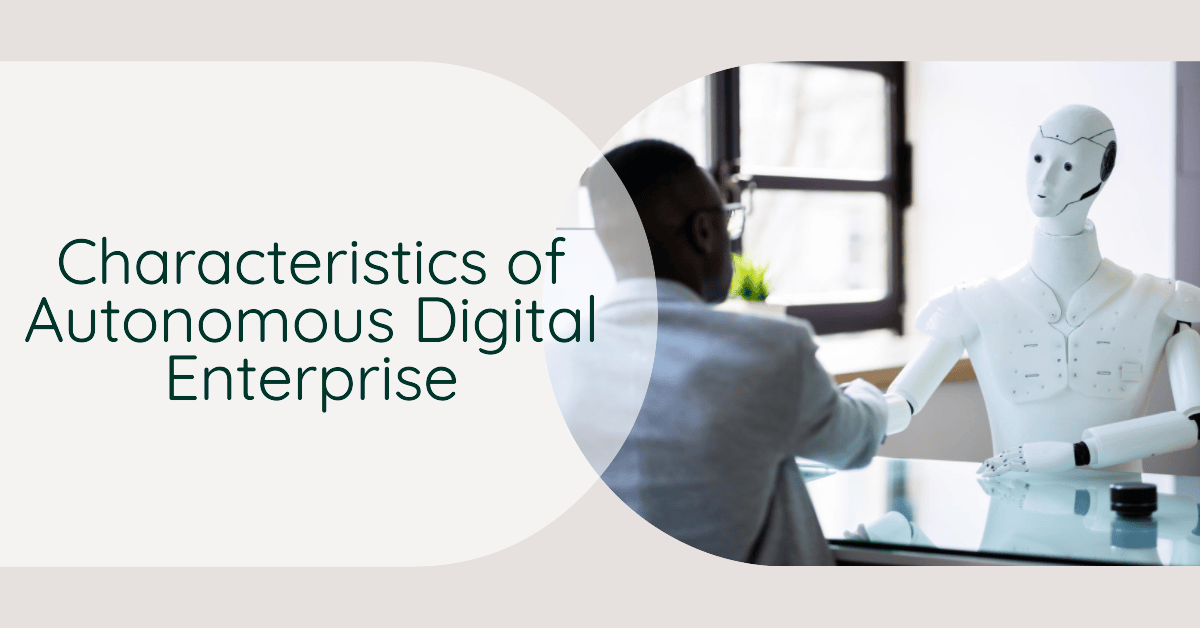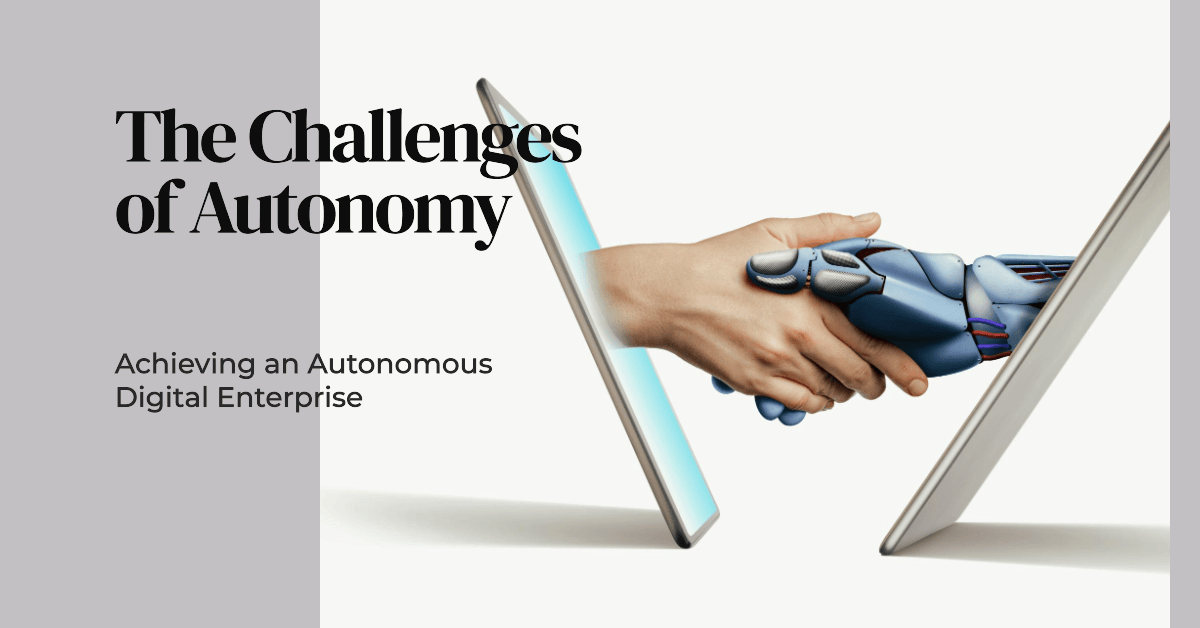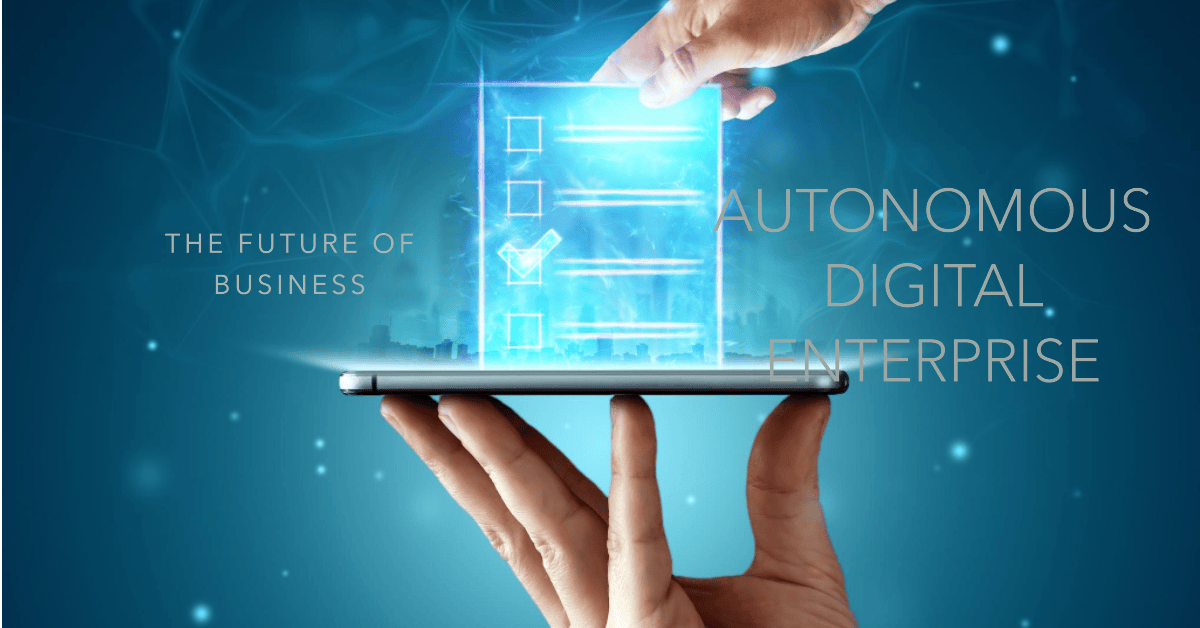Autonomous digital enterprise is a company that leverages advanced technologies like artificial intelligence, machine learning, and automation to drive business growth and operational efficiency. It utilizes data and algorithms to gain insights, make decisions, and automate processes with minimal human intervention.
The autonomous digital enterprise represents the future of business. Powered by automation and AI, it promises operational efficiency, customer centricity, and data-driven business agility. However, the path to autonomy comes with technical and cultural obstacles.
Companies must assess their readiness across several dimensions:
Technical infrastructure and architecture
Legacy systems and technical debt
Data pipelines, quality, and governance
Skills and culture
Leadership alignment and vision
After identifying gaps, companies should take steps to align business objectives and technology capabilities. This includes:
Developing a technology roadmap
Building skills in areas like automation, AI, and analytics
Creating cross-functional teams
Implementing modern tech stacks
Additionally, companies need to build a data-driven culture and implement key technologies like automation and AI to start the autonomy journey.
The rewards for overcoming these challenges are immense, but so is the commitment required. Leaders must provide support and investment to transform. While difficult, becoming an autonomous digital enterprise can unlock new levels of innovation, growth, and competitive differentiation.

Characteristics of an Autonomous Digital Enterprise
An autonomous digital enterprise has some key characteristics that set it apart from traditional companies. These include a focus on automation, AI and advanced analytics, real-time data-driven agility, and customer-centricity.
Automation Everywhere
Automation is at the core of an autonomous digital enterprise. Automating manual, repetitive processes allows companies to improve efficiency, reduce costs, and redirect human efforts to more impactful work.
Key automation technologies include:
Intelligent automation
Combines robotic process automation (RPA), AI, machine learning
Can understand unstructured data and handle complex workflows
Hyperautomation
Orchestrating multiple automation tools for end-to-end process automation
e.g. RPA + iBPMS + AI
Benefits of automation:
Increased throughput and productivity
Improved accuracy and reduced errors
Cost savings from needing less manual labor
Better customer experiences from faster resolution times
Companies should start by identifying high-opportunity workflows that are repetitive and ripe for automation. Quick wins build momentum and free up resources to take on more transformative initiatives.
AI and Machine Learning
AI and machine learning are essential capabilities for the autonomous enterprise. Key applications include:
Predictive analytics
Identify risks/opportunities based on likely outcomes
Optimization
Improve processes and decisions over time via algorithms
Personalization
Tailor products and experiences to individual customers
Natural language processing
Chatbots and virtual agents for customer service
Machine learning techniques like deep learning open new possibilities for finding hidden insights in large, complex datasets. This enables data-driven decision making across the enterprise.
However, AI success requires high-quality training data. Companies should focus on improving data management as a foundation.
Real-Time Data Analysis
The autonomous enterprise leverages real-time data and insights to react dynamically. Capabilities include:
Real-time dashboards and reporting
Enables quick response to emerging trends and issues
Event stream processing
Identify and act on critical events as they occur
Internet of things (IoT) data integration
Incorporate real-time signals from connected devices/sensors
With access to real-time, integrated data, companies can adjust strategies on-the-fly to meet customer needs and optimize operations. This level of agility was impossible just a few years ago.
Customer-Centricity
Customer-centricity is both a key input and output of the autonomous enterprise. Companies should leverage automation, AI, and data to:
Gain insights into evolving customer preferences
Deliver personalized omnichannel experiences
Provide proactive recommendations and services
Technologies like automation and AI allow companies to understand and serve customers at scale. The result is higher satisfaction, loyalty, and growth.
Becoming an autonomous digital enterprise enables a strategic approach to leverage data and technology for better business outcomes. With focus and commitment, companies can drive efficiency, innovation and differentiate from the competition.

Benefits of Becoming an Autonomous Digital Enterprise
Transitioning to an autonomous digital enterprise delivers important benefits across key business metrics like efficiency, costs, innovation, and growth.
Increased Efficiency and Productivity
By automating manual, repetitive processes, companies can boost efficiency and productivity. Benefits include:
Automation reduces manual work needed for routine tasks
e.g. automated report generation vs. manual creation
Employees redirected to higher-value strategic initiatives
e.g. analysis vs. data entry
More work gets done in less time
e.g. invoice processing time cut from 5 mins to 5 secs
According to McKinsey, 45% of work could be automated using today's technologies. Companies that leverage automation will gain a competitive advantage.
Other efficiency gains include:
Faster processing and turnaround times
Fewer errors and rework
Higher output and scalability
Cost Savings
Automation and AI provide opportunities for major cost savings:
Reduce labor costs
Need fewer FTEs for certain processes
Improve asset utilization
e.g. predictive maintenance with IoT data helps maximize uptime
Lower IT costs
Automate deployments, testing, and ops instead of manual processes
This allows budget to be redirected to innovation vs repetitive operations.
According to SSON Network, top-performing companies see >30% cost reduction from automation initiatives.
Innovation and Revenue Growth
An autonomous model also enables innovation and new sources of revenue:
Data-driven insights reveal new market opportunities
e.g. personalized offers based on purchase history
Faster speed to market
Automated development and testing pipelines
Enhanced products and services
e.g. AI features like chatbots or recommender systems
Per IDC, companies with data-driven cultures are 2x as likely to exceed revenue goals.
Improved Customer Experiences
Customer centricity improves with an autonomous enterprise:
Predictive analytics anticipate customer needs proactively
Intelligent virtual agents resolve issues faster 24/7
Real-time personalized promotions
Omnichannel engagement and fulfillment
Better customer experiences lead to higher satisfaction, loyalty, referrals, and growth.
Competitive Differentiation
Taken together, these benefits provide competitive differentiation:
Innovate ahead of competitors
React quicker to market changes
Improve efficiency that lowers costs
Exceed customer expectations
Early adopters will be positioned to dominate their industries.
Future Readiness
An autonomous model also provides better readiness for the future:
Technology landscape is continuously evolving
Expectations keep rising among customers and employees
Frequent market disruptions from agile competitors
With a data-driven and technologically advanced foundation in place, companies can continuously adapt and grow rather than being made obsolete.
Becoming an autonomous digital enterprise powers transformation across metrics from efficiency to innovation to growth. With disciplined execution and leadership commitment, the payoff can be game-changing.

Challenges in Achieving an Autonomous Digital Enterprise
While the benefits are compelling, transforming to an autonomous model also comes with major challenges to overcome.
Technical Challenges
Legacy IT systems and technical debt pose obstacles:
Integrating new technologies with legacy
e.g. critical systems may lack APIs or use outdated languages
Overcoming complex, siloed architectures
Lack of interoperability between systems
Reliance on manual processes
Existing tools weren't designed for automation
Immature data infrastructure
Low quality or siloed data makes analytics difficult
Companies must modernize technology stacks and architecture:
Assess integration readiness and API coverage
Improve data pipelines, governance, and sharing
Move to cloud platforms for scalability and agility
Build competencies in analytics, automation, and AI
Organizational Challenges
How the organization operates also needs realignment:
Breaking down silos between IT, business units, and data teams
Moving from project-based work to product-focused teams
Shifting to agile DevOps software delivery
New governance models as infrastructure becomes code
This requires changes including:
Cross-functional teams
Moving decision authority closer to self-managing product teams
Platform thinking for leverage across domains
Focus on customer outcomes rather than technical outputs
Cultural Challenges
Perhaps most challenging are needed cultural changes:
Adopting evidence-based decision making
Willingness to experiment and fail fast
Shifting mindsets to empower employees through technology vs fearing automation
New leadership, collaboration, and talent skills
More transparency and democratization of data
Some strategies to drive cultural change:
Executive leadership as role models
Change story linking autonomy to purpose and customer benefit
Training programs on digital literacy and culture
Incentives aligned to data-driven decisions and automation adoption
Financial Challenges
Autonomy initiatives also require significant investment:
New technology platforms and tools
Integration and API development
Reskilling employees and acquiring new talent
Change management and communication
Securing financial commitment involves:
Strong business case with clear ROI
Quick wins to build momentum
Roadmap to scale adoption over time
Partnering with CFOs on change story
While daunting, these challenges can be overcome with sufficient leadership commitment and smart change management. The long-term rewards make this transformation journey worthwhile.

Transitioning to an Autonomous Digital Enterprise
Becoming an autonomous digital enterprise doesn't happen overnight. Companies should follow a structured approach:
Assess Digital Maturity
First, assess the current state across key dimensions:
Technical landscape
Infrastructure, legacy constraints
Data architecture and pipelines
Automation and analytics maturity
Organizational alignment
Leadership vision and commitment
Cross-functional coordination
Change management capabilities
Cultural readiness
Appetite for experimentation
Comfort with data-driven decisions
Willingness to adopt new tech and ways of working
This analysis identifies the biggest gaps to be addressed.
Map the Data Architecture
A strong data foundation is crucial for autonomy. Key steps include:
Catalog data sources, systems, and usage
Assess quality, governance, and access
Identify high-value datasets
Fill critical gaps in collection and integration
Build pipelines for efficient analytics
This enables real-time organization-wide analytics.
Prioritize Quick Wins
The transformation roadmap should balance short- and long-term initiatives:
Quick wins build momentum and free up resources
e.g. automating manual reporting
Strategic priorities tackle high-impact changes
e.g. core system modernization
Different groups can work on each based on readiness.
Scale Automation
Start with simple task automation then expand over time:
Robotic process automation for repetitive rules-based workflows
Intelligent automation with AI/ML for complex processes
End-to-end automation coordinating multiple tools
Continually assess new processes to automate.
Develop Analytical Capabilities
Similarly, build analytics expertise incrementally:
Descriptive analytics for business intelligence dashboards
Diagnostic analytics to understand performance drivers
Predictive analytics to optimize decisions and detect risks
Prescriptive analytics to simulate outcomes of actions
This develops a data-driven culture.
Drive Cultural Change
Changing mindsets doesn't happen overnight. Tactics include:
Executive leadership as role models
Training on digital literacy and culture
Incentives aligned to automation and data-driven decisions
Celebrate wins and successes
Make sure change connects back to core business goals.
Becoming an autonomous digital enterprise takes time but pays dividends. Maintain focus on delivering customer value, start small, and continue scaling adoption across the company. With commitment and smart change management, the future autonomous enterprise can become reality.
Conclusion
The autonomous digital enterprise represents the future for companies looking to leverage technology for competitive advantage. By automating processes and leveraging data with AI, companies can achieve new levels of efficiency, innovation, and growth.
Key takeaways include:
Autonomy is enabled by automation, AI, and real-time data analysis
Benefits include increased efficiency, cost savings, innovation opportunities, and improved customer experiences
However, companies face technical, organizational, cultural, and financial challenges
Becoming autonomous requires assessing readiness, prioritizing initiatives, and managing change
With leadership commitment and sound execution, the journey can transform the business
Call to Action
We encourage companies to take the following steps to move towards an autonomous future:
Honestly assess your organization's digital maturity
Connect autonomy initiatives to core business goals
Start small with quick wins then scale what works
Build skills and culture around data and emerging tech
Maintain focus on delivering superior customer value
Stay nimble and keep iterating as technology evolves
The autonomous enterprise journey requires vision, leadership, and commitment. But with a sound approach, companies can build a resilient foundation to continually adapt and succeed.
The Future
Looking ahead, we foresee several trends for autonomous enterprises:
Expanding AI adoption and capabilities
Increasing use of edge computing resources
Advances in robotic and industrial automation
New technologies like augmented reality and quantum computing
Continuous evolution of tech stacks toward open, cloud-based platforms
To stay ahead, companies must foster a culture of innovation and experimentation powered by data. Autonomous enterprises will continually integrate new technologies to drive the next wave of transformation.
By embracing autonomy today, organizations can unleash human potential and sustain a competitive advantage. The future enterprise will leverage technology not as a threat but as an opportunity to unlock growth, efficiency and value creation. The journey requires courage and commitment, but the destination is a future ready for any challenge.


